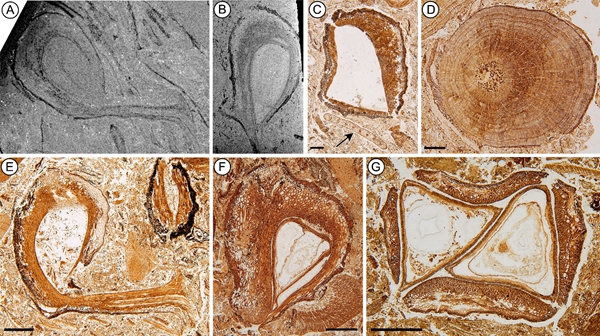Flowering plants (angiosperms) dominate most terrestrial ecosystems, provide the bulk of the food consumed by people, and contribute many other services that are critically important for life on our planet, but their origin has been a mystery since the earliest days of evolutionary thought. Angiosperm flowers are hugely diverse, but central to clarifying the origin of flowers and how angiosperms might be related to other kinds of plants, is understanding the evolution of the parts of the flower, especially angiosperm seeds and the fruits in which the seeds develop. Fossil seed-bearing structures preserved in a newly discovered Early Cretaceous silicified peat in Inner Mongolia, China, which dates from about 126 million years ago, provide a partial answer and support an earlier idea that the distinctive outer covering of developing seeds of flowering plants – the so-called second integument – is fundamentally comparable to structures that occur in certain extinct non-angiosperm seed plants from the ‘Age of Dinosaurs’.
The seeds of cycads, ginkgo and conifers are enclosed and protected by a single integument, which is believed to correspond to the inner integument in flowering plants. However, the outer (second) integument is a unique structure. Its development is linked to its curious recurved form and is controlled by different genes than those responsible for the development of the inner integument. The new fossils, which are exceptionally well preserved and abundant in the silicified peat from China, have two seeds enclosed inside a specialized recurved structure – the cupule. Similar cupules occur in several groups of extinct plants from the Mesozoic that are known only from fossils, and while it has been suggested some of these cupules may be precursors of the second integument of flowering plants, discussions have been hampered by inadequate information. The new material from China, along with the reexamination of previously described fossils, suggests that the recurved cupules found in several groups of extinct seed plants from the Mesozoic are all fundamentally similar and are the likely the precursors of the second integument of flowering plants. The recurved structure seen in the young seeds of flowering plants is therefore a hold-over from an earlier pre-angiosperm phase of evolution. Variation among extinct Mesozoic seed plants in the number of seeds per cupule and other features likely reflect differences relating to pollination, as well as seed output, protection and dispersal.
Recognition of extinct seed plants with a structure comparable to a key feature of living angiosperms provides a partial answer to the question of flowering plant origins, helps focus future work on understanding how living and fossil groups of seed plants are interrelated, and has important implications for ideas on the origin of another diagnostic feature of flowering plants that evidently came later – the carpel – the structure that forms the fruit wall in which the seeds develop.
This research was supported by the Youth Innovation Promotion Association of the Chinese Academy of Sciences (2017359), the US National Science Foundation grant DEB-1748286, the Strategic Priority Research Program of the Chinese Academy of Sciences (XDB26000000), the National Natural Science Foundation of China (41790454) and the Oak Spring Garden Foundation.
Figure 1. The fossil chert locality at the Zhahanaoer open-cast coal mine, Jarud Banner, eastern Inner Mongolia, China.

Figure 2. Fossil cupules and associated leaf and stem from the Early Cretaceous Zhahanaoer chert locality
Figure 3. Fossil cupules and seed from the Early Cretaceous Zhahanaoer chert locality
Contact:
LIU Yun, Propagandist
Email: yunliu@nigpas.ac.cn
Nanjing Institute of Geology and Palaeontology, Chinese Academy of Sciences
Nanjing, Jiangsu 210008, China
